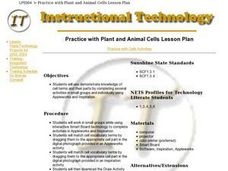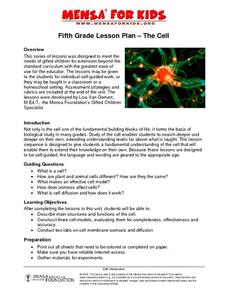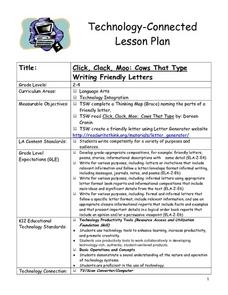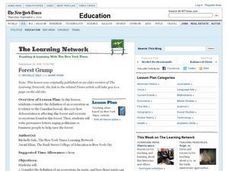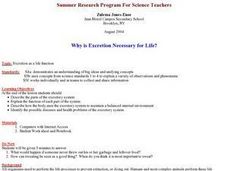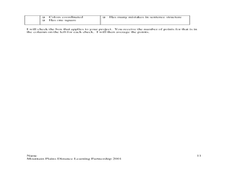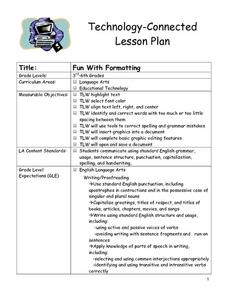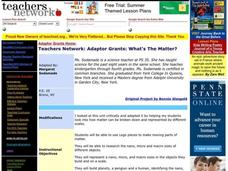Curated OER
Arthur's New Puppy Directed Reading Lesson (Elementary, Reading/Writing)
Learners listen and take part as teacher and classmates give a definition and examples of responsibility, then brainstorm what Arthur needs to do to prepare for his puppy's arrival. The story be read as a total group and then talked about.
Curated OER
Practice with Plant and Animal Cells
Students work in small groups to match cell vocabulary terms to the appropriate cell part in a photograph. They use a draw program to sketch a plant and animal cell.
Curated OER
Jammin' to Jazz
Learners identify integral parts of jazz music by listening to Quincy Jones' We Be Doin' It. They note the bass and drum sounds, scat solos, and also sing parts of the ostinato and chorus.
Curated OER
Circulatory System Design
Students identify the different parts of the circulatory system and their function. They work together to create their own model of the system and use it to determine the rate of blood flow. They answer questions related to their model.
Curated OER
The Cell
Tenth graders explore the parts of a cell. In pairs, classmates construct a model of a eukaryotic cell, detailing its morphology and function. With the use of computer technology, 10th graders create cell book for middle schoolers. ...
Curated OER
Cows That Type Friendly Letters
Students engage in a instructional activity that introduces the parts of a letter. The instructional activity is taught using a powerpoint presentation with the purpose of integrating technology into instruction. Students create a letter...
Curated OER
Forest Grump
Learners consider the definition of an ecosystem, its parts, and how these parts can be affected when the ecosystem is endangered. They examine dangers being faced by the Canadian boreal forest by reading "For Billions of Birds, an...
Curated OER
Respiratory System
Students identify the parts of the respiratory system and how they interact. They define vocabulary words and draw an outline of themselves and label the parts of the respiratory system. They distinguish between healthy and unhealthy...
Curated OER
Stop the Bleeding
Students explore various parts of the heart and blood vessels . They begin with an overview of the components of the cardiovascular system. They see a cross section of an artery and watch how a blood clot develops.
Curated OER
Why is Excretion Necessary for Life?
Pupils describe and explain the function of each part of the excretory system. They discuss how the body uses the excretory system and identify diseases of the system.
Curated OER
Quilt Squares
Students research the history of the quilt in American History and view a PowerPoint Presentation. They create a quilt square with colored paper using polygons, transformations, rotations, and reflections on the computer and on a...
Curated OER
Fun With Formatting
Students investigate the concept of using a word processing program with the intention of improving formatting skills like centering text. They also highlight different text sections and demonstrate how to save changes made to a document...
Curated OER
Zulu King, Zulu King
Learners listen to story Brown Bear, Brown Bear, brainstorm everything they know about Mardi Gras, create pages relating to Mardi Gras for class book, type information on computer, play slide show, and take turns reading their books.
Curated OER
Electricity/Magnetism
Fourth graders explore magnets as fundamental parts of generators and how they are used to produce current electricity. They distinguish between the north and south pole of magnets and the difference between repel and attract. Students...
Curated OER
Exploring Teen Numbers
Students explore place value. For this numeration lesson, students use ten frames to represent numbers greater than ten. Students read two digit numerals and build the corresponding number using counters and ten frames. ...
Curated OER
Habitat for Plants! There's No Place Like Home!
Students compare and contrast conditions necessary for survival of aquatic and terrestrial plants, identify common and scientific names of plants,
and determine correlation between location and plant characteristics. Students then use...
Curated OER
What's The Matter
Students identify and describe the different stages of matter. In groups, the use lego pieces to represent the moving parts of matter. They use the internet to research the meanings of nano, micro and macro sizes. They also use the...
Curated OER
Brush Up On Your Teeth
Third graders examine the reasons why it is important to take care of their teeth. As a class, they sing the toothbrush song and read about tooth decay. They identify the parts of the teeth and identify foods that can keep the mouth...
Curated OER
Life Cycle of the Butterfly
Students observe and analyze the life cycle and metamorphosis of the Painted Lady Butterfly. They write observation journal entries three times a week and summarize what they observed. Using KidPix computer software they create pictures...
Curated OER
Language Arts: Inside, Outside, Upside Down
Students create a computer slide show of pictures representing directional words. After listening to several books with examples, they pair words such as inside and outside, below and above, or high and low. With older students or...
Curated OER
Projectile Motion Lab
In this physics instructional activity, students model the position, velocity and acceleration using mathematical formulas and a computer program. Then they interpret the parameters in each of the models. Students also complete the...
Curated OER
Measuring Inches and Centimeters
In this math worksheet, students learn to measure common classroom objects or body parts using a standard inches ruler and a centimeter ruler. Students measure 21 objects in both ways.
Curated OER
Similar/Different: Nervous System
In this nervous system worksheet, students identify 2 ways that a computer and brain, a telephone wire and the spinal cord and a camera and an eye are similar and different.
Curated OER
Action Painting on a SMARTboard
Students learn about Jackson Pollock, an artist famous for "action painting," and his works in order to become familiar with his artistic style. In this art lesson, students view Pollock's pieces, then watch a slideshow and video...



